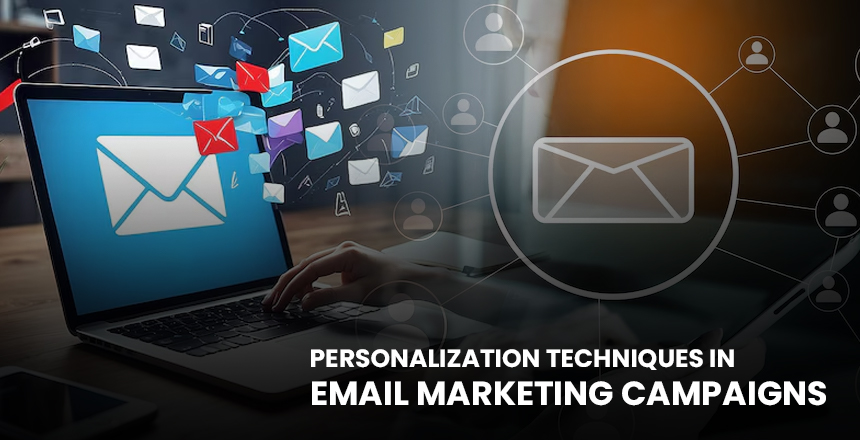In the fast-paced world of digital marketing, email continues to reign as one of the most
effective communication channels for businesses. But the effectiveness of an email
campaign lies not just in its design or content but also in how well it resonates with the
recipient. Personalization in email marketing has proven to be the key to enhancing user
engagement, increasing open rates, and driving conversions. This blog explores some of the
most effective personalization techniques that marketers can use to optimize their email
campaigns.
Segmentation: The Foundation of Personalization
Segmentation is the process of dividing your email list into smaller, more targeted groups
based on specific criteria. These groups may be segmented based on demographics,
behavior, purchase history, or other attributes. For example:
- Demographic Segmentation: Segmenting by age, gender, location, or income.
- Behavioral Segmentation: Targeting users based on their interaction with your website or emails.
- Psychographic Segmentation: Addressing preferences, interests, and values.
By delivering emails tailored to these segments, marketers can ensure content relevance,
making recipients more likely to engage.
Personalized Subject Lines
The subject line is often the first thing a recipient notices in their inbox, and it plays a pivotal
role in whether the email gets opened. Personalizing subject lines with the recipient’s name
or specific details (like recent purchases or interests) can significantly boost open rates.
Example: “Hi John, Don’t Miss Out on These Deals for Your New Home!”
A study by Experian found that personalized subject lines generate 26% higher open rates,
proving how impactful this small tweak can be.
Dynamic Content
Dynamic content allows marketers to customize sections of an email based on the recipient’s
preferences or behaviors. For example, an e-commerce brand could display product
recommendations tailored to each user’s browsing history.
Example: A clothing retailer might showcase winter coats to users in colder regions and
summer dresses to those in warmer climates.
Dynamic content ensures that every recipient feels that the email is crafted specifically for
them, improving engagement.
Behavior-Triggered Emails
Triggered emails are sent automatically based on specific user actions or behaviors. These
could include:
- Welcome Emails: Sent when a user subscribes to your list.
- Cart Abandonment Emails: Reminders sent when a user leaves items in their cart without completing the purchase.
- Post-Purchase Emails: Follow-ups after a customer has made a purchase, which could include thank-you notes or product recommendations.
Behavior-triggered emails are highly personalized and timely, making them extremely
effective in driving conversions.
Using Customer Data for Personalization
Leveraging customer data, such as browsing history, purchase records, or interaction
metrics, allows marketers to craft hyper-personalized email content. For example:
Recommending products similar to what the recipient has previously purchased.
Sending birthday emails with a discount code.
Offering content that aligns with the recipient’s past interactions with your brand.
Using data responsibly and transparently is crucial to building trust with your audience while
enhancing personalization.
Location-Based Personalization
Emails personalized to a recipient’s location can create a sense of relevance and immediacy.
For instance:
- Promoting in-store events in the recipient’s area.
- Displaying weather-appropriate product recommendations.
- Sending localized offers based on regional preferences.
- Location-based personalization is especially effective for businesses with physical stores or region-specific services.
Send Time Optimization
Knowing the best time to send an email can make a significant difference in open and
click-through rates. By analyzing user data, marketers can determine when their audience is
most likely to check their inbox. Some email marketing tools even use AI to optimize send
times for individual recipients.
For instance, an email sent at 9 AM on a Monday may perform better for a corporate
audience, while a weekend email might resonate more with casual shoppers.
Interactive Elements in Emails
Adding interactive elements like polls, quizzes, or clickable product carousels can make
emails more engaging and personalized. For example:
A quiz recommending products based on the user’s preferences.
A poll asking for feedback on a recent purchase.
Interactive elements not only engage the audience but also provide valuable data for future
personalization efforts.
Personalized Content Recommendations
For content-based businesses, such as media companies or blogs, recommending articles
or videos based on a subscriber’s past reading or viewing habits can keep them engaged.
Example: “Based on your interest in tech gadgets, here are 5 reviews you’ll love.”
This technique keeps the content relevant and increases the likelihood of the recipient
interacting with the email.
A/B Testing for Personalized Campaigns
A/B testing allows marketers to test different versions of an email to see what resonates best
with their audience. For instance:
Testing subject lines with and without personalization.
Comparing emails with different layouts or call-to-action placements.
By analyzing the results, marketers can refine their personalization strategies and improve
campaign performance over time.
Leveraging Artificial Intelligence (AI)
AI has revolutionized personalization in email marketing by enabling predictive analytics and
automated recommendations. AI tools can:
Predict the type of content a recipient is likely to engage with.
Automatically personalize subject lines and email content.
Optimize send times for maximum impact.
By integrating AI into their email marketing strategy, businesses can achieve a level of
personalization that was previously unattainable.
Continuous Feedback and Refinement
Personalization is not a one-time effort. It requires continuous refinement based on user
feedback and engagement metrics. Regularly analyzing data and adapting your strategies
ensures that your emails remain relevant and effective.
For instance:
Monitoring open rates, click-through rates, and conversion rates to identify areas of
improvement.
Conducting surveys to understand user preferences and expectations.
Conclusion
Personalization is no longer optional in email marketing—it is essential. By leveraging
techniques such as segmentation, dynamic content, behavior-triggered emails, and
AI-powered insights, marketers can create highly tailored campaigns that resonate with their
audience. The key is to focus on delivering value and relevance, ensuring that every email
feels like it was crafted specifically for the recipient.
In a world where consumers are inundated with generic messages, personalized email
campaigns stand out, fostering stronger relationships and driving greater results for your
business.








